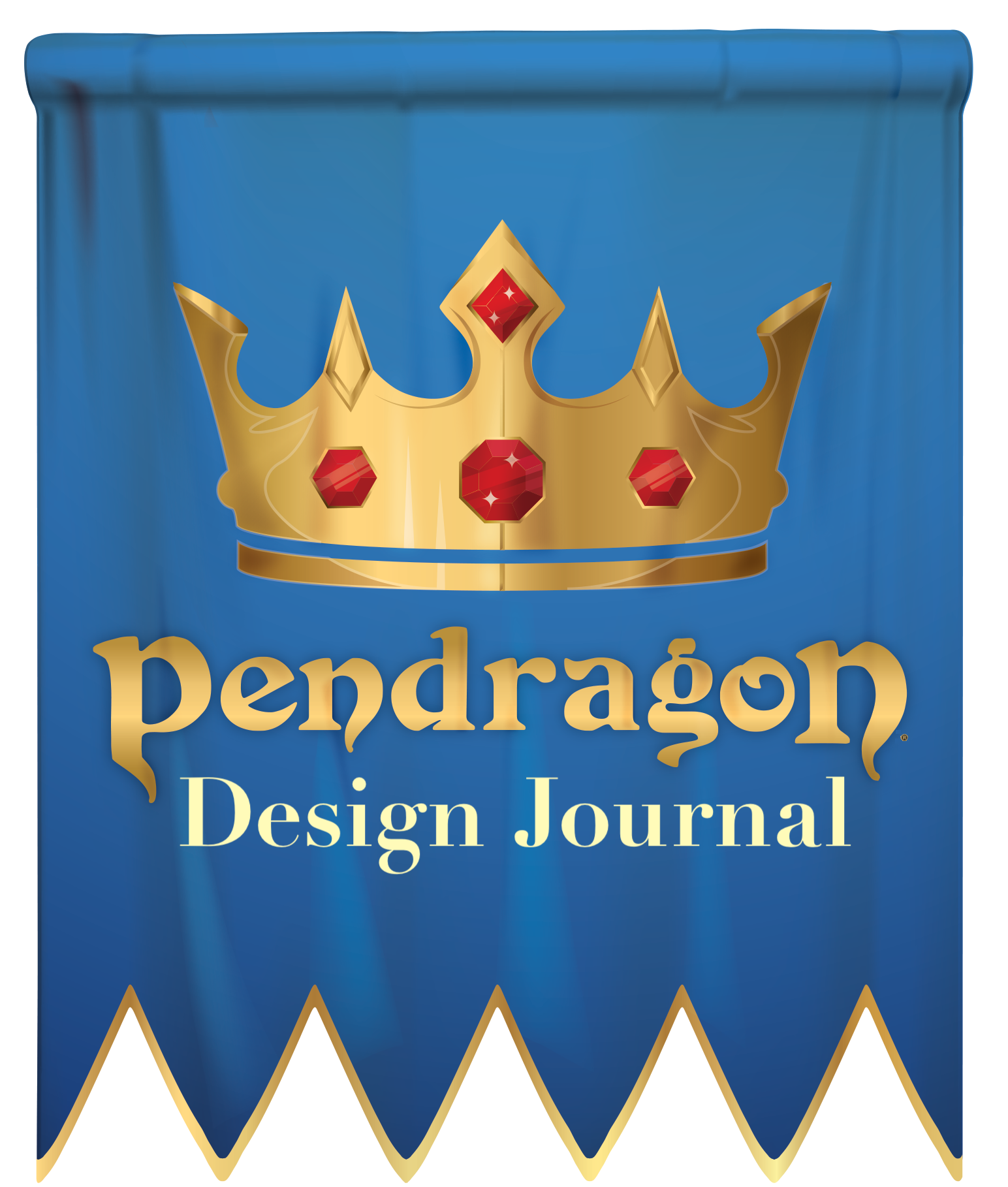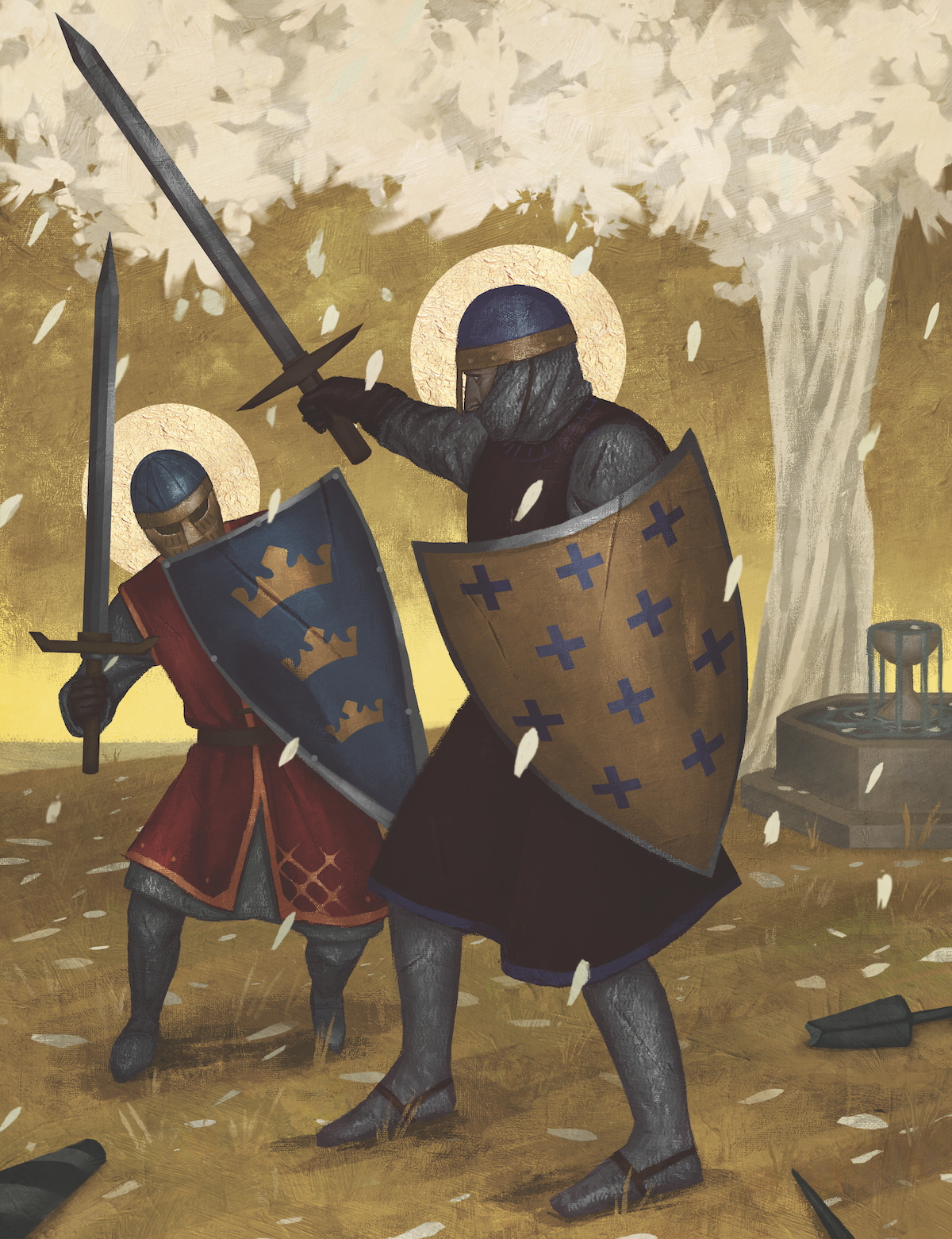
By David Larkins, Pendragon line editor.
A new edition of the Pendragon RPG is coming! The intention of this series of design journals by Pendragon line editor David Larkins is to trace the path of development, starting in the early 1980s and culminating with the forthcoming new edition of the Pendragon RPG, which will be first to be wholly published by Chaosium in a quarter-century.
- Pendragon Design Journal #1: Where It All Began
- Pendragon Design Journal #2: Bringing the Light
- Pendragon Design Journal #3: A Modular Approach
- Pendragon Design Journal #4: Refining Traits and Passions
- Pendragon Design Journal #5: Honor and Glory
“History, romance, and legend all agree that fighting is a knight’s primary work.” — so begins the Combat chapter of the forthcoming Pendragon 6th Edition Core Rulebook.
For knights, combat is both a deadly necessity and one of the best ways to gain Glory—both for the vanquishing of enemies and as a means to an end. The new edition retains the deadliness of earlier iterations, but one of Greg’s top priorities in his work on this - his ultimate edition - was to present the most clearly-explained, exciting, and immersive take on Pendragon combat yet seen.
For this month’s Design Journal, I am taking a look at a few of the changes I particularly like for combat in 6th Edition.
Clearer Definitions
Greg and our team of developers and editors took great care in explicating combat actions, trying to eliminate as many gray areas from previous rules as possible. Mounted Charges are clearly defined, and even include some fun extra elements which I’ll talk about below. Grappling and brawling work smoothly and intuitively. It feels like, in my playtests over the past couple years, I have seen more shield rushes, takedowns, and other creative close-quarters combat than in all my prior years of running Pendragon!
And it’s not limited strictly to grappling. In my latest session earlier this week, a Player-knight, having lost their weapon, wished to use his horse against a knocked-down opponent who was trying to get up again. Thanks to the clearly-defined list of combat actions, he saw he could attempt to Trample his foe and did so! (Horses in 6th edition now have a non-charging Damage statistic to go with their charging Damage, so it’s possible to determine just how much it hurts to have a charger step on you. Answer: it ain’t fun!)
Mounted Charges
The definitive image of the knight in combat has to be the mounted lance charge, and I absolutely love the improvements Greg made to this fundamental combat action.
The basic mechanic is the same, though all mounted charges now use the Charge Skill. (Charging with a lance remains the best tactic by far, but in a pinch you can attempt to charge in swinging your sword or axe.) It’s the small changes, though, that I like so well, the ones that add more flavor to the play experience and solve persistent in-game problems.
For example, whether you play with miniatures or use theater of the mind, the game has been a little hazy on questions of where someone ends up after a mounted charge, and whether they’re able to charge again. Now, when you need to know the answer to this sometimes quite vital question, a quick consultation of your horse’s Movement Rate and the outcome of your prior Mounted Charge Action determines the post-charge distance between you and your opponent, and tells you how much space you need to get up to speed for another Mounted Charge. Want to target multiple opponents on a charge? The rules tell you how you can do that based on distance traveled as well.
My favorite addition, though, has to be the rules for charging fumbles and ties.
If you’ve ever read period accounts of jousts and lance charges, you know that a lot can go wrong. In 6th edition, Greg added simple rules (baked into the normal resolution process) for determining if you crash into your opponent’s steed with your own, or whether two knights armed with lances manage to knock each other out of their saddles simultaneously (something that happens all the time in the literature); the danger posed by flying splinters from shattered lances; even the remote (yet always hilarious) possibility of accidentally pole-vaulting yourself off your horse when your lance buries itself in the ground! (Even though there is only a 1/400 chance of this happening, I’ve seen Player-knights pull it off more than once…)
Weapons and Armor
I’ve talked in the past, both in this column and in interviews, about how I feel that Pendragon 6th edition manages to feel a bit more immersive in its medieval trappings. This is due to a variety of factors, but one of the big ones for me is in the department of weapons and armor.
Weapons carry specific names now. There is both a qualitative and mechanical difference between an arming sword and a longsword, for example. However, Weapon Skills are now more generalized: both of those blades are wielded using the Sword Skill. The One-Handed Hafted Skill covers both battle axes and maces. Furthermore, because we assume knights have trained at least a bit with every weapon, all Weapon Skills default to DEX/2.
This eliminates the problem of earlier editions, which had so many Weapon Skills, many starting at 0, that Player-knights tended to specialize in just one or two weapons, and trying to play catch-up when a new weapon appeared on the scene was throwing good Skill points after bad.
With the new system, I’ve experienced much more variety in how knights arm themselves, and we see a genuine arms race develop over the course of the campaign. Although the arming sword and lance reign supreme on the battlefield during the Boy King Period, by Twilight any knight worth their salt is going into battle with a Longsword and Pollaxe!
Armor, likewise, now feels more satisfying and flavorful in the game. Knights assemble their harnesses by combining various pieces in three categories: padding, armor, and helmet. Rather than generic descriptions like Partial Plate, your knight of the Conquest Period might go into battle wearing a coat of plates over an aketon, with a great helm and cervelliere to protect their noggin.
Helmets are a vital piece of the harness, but as always a closed helm imposes penalties to Awareness; removing your helm to get a better look at things definitely makes you more vulnerable! On the other hand, a knight caught by surprise, sleeping in their aketon, might only have time to pop on a nasal helm before rushing into battle.
It’s these little changes (and the fact that they’re organic parts of an already robust and streamlined system) that make combat in 6th edition so much fun for me.

Art: "Fight Between Knights" by Eleonor Piteira
